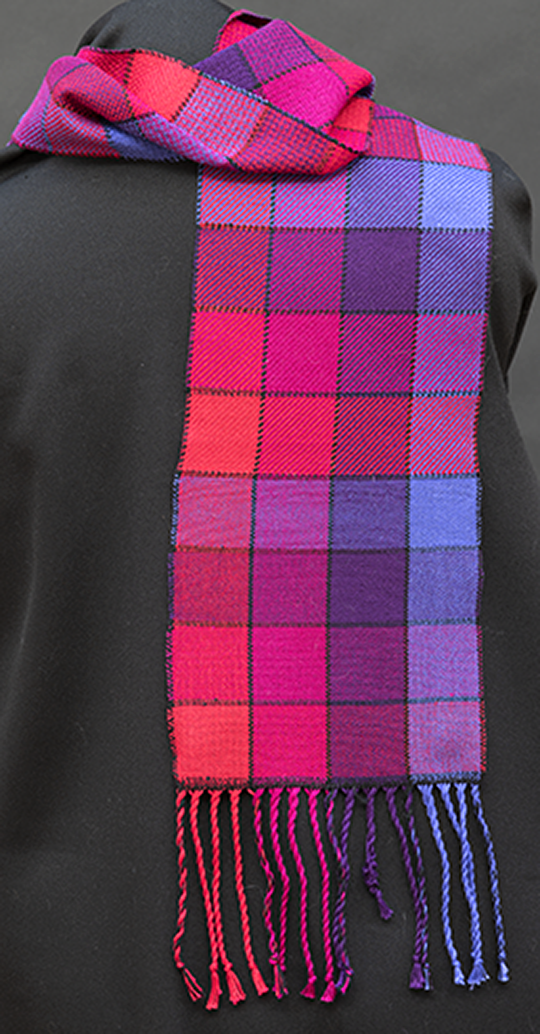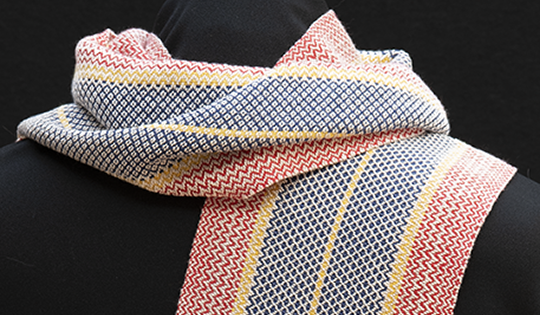| Giving Weight to your Project |
Marcy Petrini
December, 2023
Throughout this month I have been working on organizing Roc Day, the celebration of spinners returning to our crafts. This year my guild, the Chimneyville Weavers and Spinners Guild, is hosting the event for the Gulf state guilds. Even though the traditional Roc Day is January 7th, the day after Epiphany, we always celebrate on the Saturday closest to Roc Day to allow people to travel if they have week-day responsibilities. This coming year it will be January 6, 2024.
The Craftsmen’s Guild of Mississippi is our co-sponsor, and the event will be held at the beautiful Bill Waller Craft Center in Ridgeland, MS with the help of the wonderful CGM staff.

We have goodie bags and every time that our guild hosts, I provide a small card with useful information – that’s the teacher in me. At least I hope it will be useful to others.
This year the information is for weavers. A lot of spinners weave on a variety of looms, so I want to offer a concept that many weavers – or spinners – don’t think about. There will be a card in the goodie bags with the information.
When I am planning a project with a new yarn, I like to think about how much the fabric is going to weigh – not how much yarn I need, that’s in the planning. I am considering the weight of the finished project to compare with other, similar projects.
Since most weavers are familiar with mercerized cotton, I decided to make the comparison using the most common of those cottons. Below is a scarf using 10/2. How does it compare with the other cottons?

My usual scarf is 8” width on the loom, which becomes approximately 7.5” after wet finishing. Generally, the finished length is 60”.
For ease of calculations, I used 8” as the finished width, as it is easier to think in whole numbers.
To obtain the weight of the hypothetical scarves, these were my calculations: (“*” is the multiplication symbol I prefer to use):
8” * sett for twill *60” *2 / 36
The setts I used in the example are those I generally use for twills. The calculation assumes that the fabric is balanced, that is, the picks per inch is the same as the sett; thus, there will be the same amount of warp and weft in the finished fabric. Therefore, I multiplied the warp calculations by 2. Since yarns are listed as yards per oz., I divided by 36 to convert inches to yards.
Here are the results:
|
Yarn |
3/2 |
5/2 |
10/2 |
|
Sett epi |
12 |
18 |
24 |
|
Yards/Ounce |
75 |
130 |
260 |
|
Yarn in scarf |
320 |
480 |
640 |
|
Weight of scarf |
4.3 |
3.7 |
2.5 |
Clearly a scarf with 3/2 cotton is heavier than 10/2. How heavy we want to make a scarf is a matter of preference, but we need to remember that weight effects drape, the lighter the scarf, the more the drape, although fiber is an important component as well.
The other two yarns that I use a lot are 10/2 Tencel™ and 20/2 silk. Tencel™ uses the same yarn count as cotton, so the 10/2 column in the table above applies to Tencel™ as well. However, Tencel™ is slicker, I like its drape better for scarves. It also has more luminosity, reflecting the light well. Below is a scarf with Tencel™ for warp and weft.

Silk has even more drape and luminosity than Tencel™. I like 20/2 silk, which is close in size to 10/2 cotton. I usually sett it at 24 epi for a twill, even though it has fewer yards per oz., 233 as opposed to the 260 in the table above. With the same sett and dimension the scarf in silk weights 2.7 oz, rather than the 2.5 for 10/2. The silk, however, drapes beautifully. Below is a silk scarf.

The weight calculation is approximate. Small differences can affect the results: slightly different dimensions, beat and sett not identical, and fringes from the warp. The comparison, however, is still useful.
In particular, however, it is important to remember that the yarn, not the heddle or reed determine the sett. I have a rigid heddle with 12 dent, I don’t sett every yarn at 12. If the sett is too open, the weft tends to pack in and results in a weft-dominant structure. The extra weft can increase the weight of the fabric by as much as 50% above that of a balanced cloth.
Once I am satisfied with my yarn choice, I proceed to the usual calculations to determine how much yarn I need for the project.
Next time you decide to use a new yarn, do a quick calculation, and check how the weight compares with other fabrics and whether that yarn is the best option for the project.
Happy Weaving and Happy Creative 2024!
Marcy
